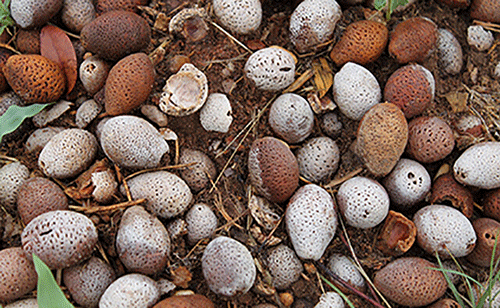Absalom Shigwedha
The Namibia Nature Foundation (NNF) recently donated manketti harvesting starter kits to 200 manketti harvesters in Maurus Nekaro and Kapinga Kamwale conservancies in an effort to support sustainable utilisation of natural resources in communal areas.
The manketti are fruits of the mangongo tree. They are also known as mongongo fruits, mongongo nuts, or simply mangongo. The egg-shaped, velvety fruit ripen and fall between March and May each year.
The Kapinga Kamwale conservancy is in Kavango East region, while the Maurus Nekaro conservancy is located in Kavango West region. NNF official in Kavango East Allan Jiji said the starter kits were bought with funds from the Climate Change and Inclusive Use of Natural Resources (CCIU) project.
The CCIU project is being implemented by the environment ministry, with funding from the German Agency for Technical Cooperation (GIZ), commissioned by the German Federal Ministry for Economic Cooperation and Development together with the European Union.
The project aims to increase the capacities of the population and responsible institutions for resilient, inclusive, and climate-adapted natural resource management. About half of all Namibians live in rural areas and depend on the use of natural resources for their livelihoods.
Through the delegation of rights to utilise natural resources under the Community-Based Natural Resource Management (CBNRM) approach, communities are able to generate benefits from this utilisation, thus leading to important incentives to conserve and safeguard the environment they live in and depend on.
Jiji explained that last year, a total of 292 community members from Maurus Nekaro and Kapinga Kamwale conservancies received training on sustainable harvesting techniques from officials from the NNF, financed by the Permanent Okavango River Basin Water Commission (OKACOM).
In order to make use of the skills acquired, it was identified through the training that each of the harvesters was in need of a manketti harvester starter-kit. Manketti can be found throughout the inland areas of both conservancies. The harvesting of the nuts is conducted from April to May and a single tree can produce as many as 900 nuts. On average 1kg of nuts is sold for about N$20.
The harvesting starter kit includes 200 knives, 200 axes, 200 nets, and 200 bags for both conservancies to assist in a successful and sustainable harvest. The income that can be generated from harvesting trees such as the manketti provides an opportunity for conservancy members to diversify their income.
“We are very happy to have been acknowledged and identified as beneficiaries of this support. These kits will surely assist us in the successful harvesting of manketti for the betterment of our livelihood,” chairperson of the Kapinga Kamwale conservancy Thomas Muronga was quoted as saying.
Vice chairperson of the Maurus Nekaro conservancy Joseph Katura, said the support will help provide income to remote villages and especially an additional income for the local women. In 2019, the Centre for Research, Information, Action in Africa and the Southern Africa Development Consulting (CRIAA-SA-DC), with support from GIZ – conducted a workshop on manketti – one of Namibia’s indigenous tree species, to find out what more can be derived from its nuts and fruits.
The flesh pulp of the plum-shaped manketti fruit is used as a relish and eaten raw or cooked. The flesh is also used in brewing a hot liquor known as Ombike (in Oshiwambo). The nut can be crushed and the kernel added to meat or vegetables to make tasty soup or gravy, while the shell is used as fuel for fire and the leaves are used as fodder.
The wood, especially the trunk, is used to make canoes.


